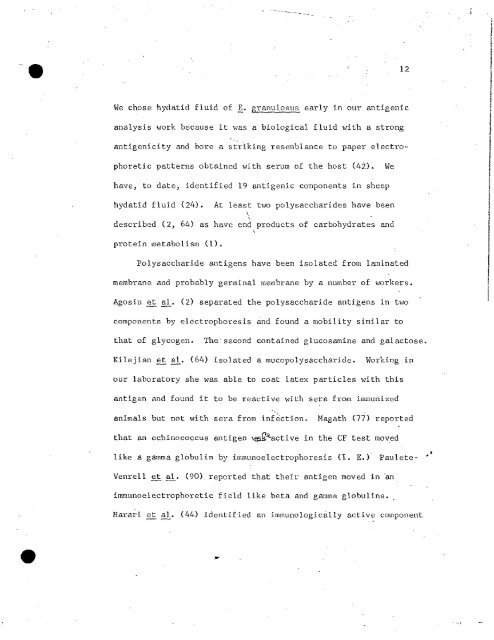CHARACTERIZATION OF PARASITE ANTIGENS ... - PAHO/WHO
CHARACTERIZATION OF PARASITE ANTIGENS ... - PAHO/WHO
CHARACTERIZATION OF PARASITE ANTIGENS ... - PAHO/WHO
You also want an ePaper? Increase the reach of your titles
YUMPU automatically turns print PDFs into web optimized ePapers that Google loves.
*<br />
e· -12<br />
We chose hydatid fluid of E. granulosus early in our antigenic<br />
analysis work because it was a biological fluid with a strong<br />
antigenicity and bore a striking resemblance to paper electro-<br />
phoretic patterns obtained with serum of the host (42). We<br />
have, to date, identified 19 antigenic components in sheep<br />
hydatid fluid (24). At least two polysaccharides have been<br />
described (2, 64) as have end products of carbohydrates and<br />
protein metabolism (1).<br />
Polysaccharide antigens have been isolated from laminated<br />
membrane and probably germinal membrane by a number of workers.<br />
Agosin et al. (2) separated the polysaccharide antigens in two<br />
components by electrophoresis and found a mobility similar to<br />
that of glycogen. The second contained glucosamine and galactose.<br />
Kilejian et al. (64) isolated a mucopolysaccharide. Working in<br />
our laboratory she was able to coat latex particles with this<br />
antigen and found it to be reactive with sera from immunized<br />
animals but not with sera from infection. Magath (77) reported<br />
that an echinococcus antigen xa- active in the CF test moved<br />
like a gamma globulin by immunoelectrophoresis (I. E.) Paulete-<br />
Venrell et al. (90) reported that their antigen moved in an<br />
immunoelectrophoretic field like beta and gamma globulins.<br />
Harari et al. (44) identified an immunologically active component
















